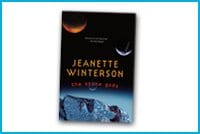It’s hard to believe that Jeanette Winterson’s literary career began more than 20 years ago; she might suggest that it began when she was born in 1959 or perhaps with the first incidence of the written word. In her new novel, The Stone Gods, she thoroughly enjoys playing with creation narratives and ideas about origins so it doesn’t seem too far-fetched to say that she could find a way to position herself and her work in a universal continuum of literary work that extends across time and space and genre. This new novel flirts with the science fiction/fantasy genre and at the same time it’s all Winterson. This is to say it’s very heady and abstract at times but also has great gusts of sentimentality and earthiness.
The novel has three sections, one featuring an apparently futuristic exhausted world set on a planet called Orbus that can no longer sustain human life since the humans living there have all but destroyed the environment. Their only hope is a newly discovered planet, Planet Blue, which appears capable of supporting human life. Life on Orbus, according to the narrator Billie Crusoe, is a post-capitalist, post-aging society in which cops are robots and robots are being designed to have feelings, as in the case of the other main character, Spike, an omnisexual robo sapiens. Another feature of life on Orbus is genetic fixing, a process that allows people to choose an age and then have their DNA fixed at that age. As she puts it, “age is information failure. The body loses fluency… for centuries we couldn’t fix that — and now we can. Science can’t fix everything, though — women feel they have to look youthful, men less so and the lifestyle programs are full of the appeal of the older man. Everybody wants one — young girls and gay toyboys.”
Other features include a cashless economy, state-run sex clubs and unbreathable air. Life on Orbus is a vivid depiction of a post-capitalist, out-of-control consumer culture that is headed for extinction with escape being the only hope for human survival. Like most human endeavours, however, the escape is something of a disaster as well. Winterson drives home the point that we as a species seem completely incapable of learning anything from the past and at times seem almost pathologically determined to destroy ourselves and our environment.
She ends the opening section on a particularly poignant note and then shifts gears dramatically to an 18th-century setting on Easter Island (home to the mysterious sculptures whose origins are inexplicable, until now that is) which again presents an exhausted world on a different scale. The island has been systematically deforested and is populated by warring religious factions, each one following a seemingly bizarre leader, to the point of self-destruction. For the reader the ideological elements of the novel become increasingly clear in this brief, historically based section.
Winterson then shifts into a more familiar gear in the concluding section of the novel. She plays with ideas about identity and attachment and talks about the significance of art, culture and a few other things along the way.
Not many novelists are given the kind of opportunity that Winterson was handed when an editor at her British publisher left a draft version of the novel on the subway. The person who happened to pick it up was a Winterson fan and was able to return it to the publisher. It likely wasn’t the only copy of the manuscript, but it makes for a great story and Winterson, being the kind of writer that she is, is able to incorporate the story of the lost and found manuscript into the final version of her story.
When she returns the official story she recreates a character named Crusoe and a prototypical, experimental robot named Spike who find themselves living in what Winterson calls a Post-3 world, which sounds remarkably like the world in the first section. What we think of as first world is run by a corporation called MORE, there is no cash only credits that people can spend on goods and services produced by the aforementioned corporation, there are no fossil fuels left, and much of the world has been rendered uninhabitable by a nuclear event related to the third world war that has taken place.
Winterson has fashioned an elaborate, alternate reality and at the same time turned the history of her own novel on its head. That’s the great thing about a Winterson novel, you might think you know where you’re headed or even where you have come from but it all turns out to be a bit different than you thought.

 Why you can trust Xtra
Why you can trust Xtra


